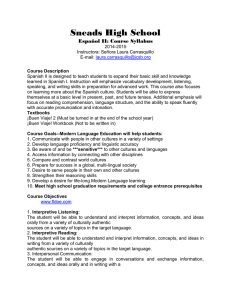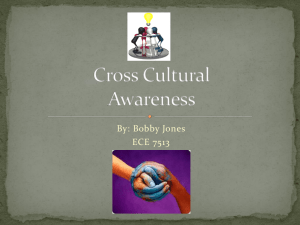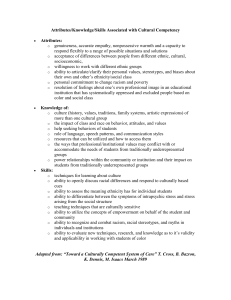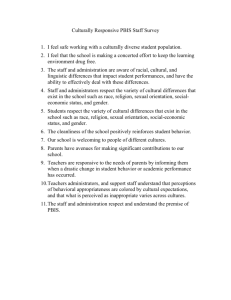2008 Kentucky licensing Regulations: Cultural activities
advertisement
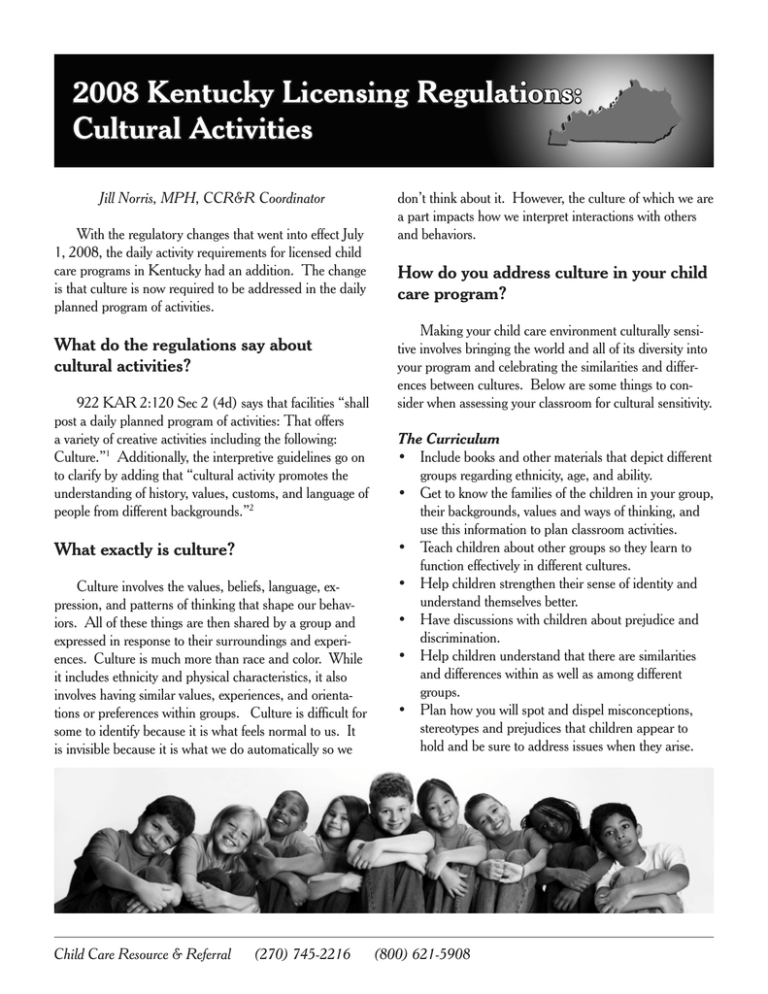
2008 Kentucky Licensing Regulations: Cultural Activities Jill Norris, MPH, CCR&R Coordinator With the regulatory changes that went into effect July 1, 2008, the daily activity requirements for licensed child care programs in Kentucky had an addition. The change is that culture is now required to be addressed in the daily planned program of activities. What do the regulations say about cultural activities? 922 KAR 2:120 Sec 2 (4d) says that facilities “shall post a daily planned program of activities: That offers a variety of creative activities including the following: Culture.”1 Additionally, the interpretive guidelines go on to clarify by adding that “cultural activity promotes the understanding of history, values, customs, and language of people from different backgrounds.”2 What exactly is culture? Culture involves the values, beliefs, language, expression, and patterns of thinking that shape our behaviors. All of these things are then shared by a group and expressed in response to their surroundings and experiences. Culture is much more than race and color. While it includes ethnicity and physical characteristics, it also involves having similar values, experiences, and orientations or preferences within groups. Culture is difficult for some to identify because it is what feels normal to us. It is invisible because it is what we do automatically so we Child Care Resource & Referral (270) 745-2216 don’t think about it. However, the culture of which we are a part impacts how we interpret interactions with others and behaviors. How do you address culture in your child care program? Making your child care environment culturally sensitive involves bringing the world and all of its diversity into your program and celebrating the similarities and differences between cultures. Below are some things to consider when assessing your classroom for cultural sensitivity. The Curriculum • Include books and other materials that depict different groups regarding ethnicity, age, and ability. • Get to know the families of the children in your group, their backgrounds, values and ways of thinking, and use this information to plan classroom activities. • Teach children about other groups so they learn to function effectively in different cultures. • Help children strengthen their sense of identity and understand themselves better. • Have discussions with children about prejudice and discrimination. • Help children understand that there are similarities and differences within as well as among different groups. • Plan how you will spot and dispel misconceptions, stereotypes and prejudices that children appear to hold and be sure to address issues when they arise. (800) 621-5908 • Introduce children to persons of varying backgrounds and occupations. • Help children to understand that different groups might perceive the same events or situations very differently. The Classroom • Use images on the walls, posters, and bulletin boards that reflect the diversity of the children in the classroom, the program, the community, and the U.S. • Avoid stereotypes in career pictures and materials that represent cultural groups. • Include colors, textures, and patterns from other cultures to your art center. Add origami paper for folding, rice paper for painting, and red potter’s clay for sculpting. Allow children to cut out pictures of people from various ethnic groups from magazines for collages. Stock up on “ethnic colors” of paper, paints, crayons, and markers. • In the block center, include a variety of transportation toys such as, bicycles, trains, double-decker buses, planes, cars, horses and carts, ferries, canoes, sleds, and sleighs. Add people that reflect various cultures, ages, abilities, and family makeup. Add natural materials for building, such as palm leaves, coconut shells, cornhusks, pine branches, straw and stones. Display pictures of various types of housing and buildings from around the world. Add toy animals made from different materials like plastic, cloth, wood and carved bone. • In your dramatic play area, include different types of food storage and cooking containers, such as woven baskets, mesh bags, tortilla presses, woks, and bamboo steamers. Add dishes and eating utensils such as wooden bowls, chopsticks, and teapots. • Evaluate materials carefully to make sure they are culturally appropriate, historically accurate, and nonstereotypical. • Use pictures and books showing differently abled people doing productive, competent things. The Atmosphere • Encourage respect for others – no name calling, put downs, or making fun of others. Always model respect. • Help children understand it is not okay to leave someone out or not play with them because of what they ccrr.expert@wku.edu look like or because they belong to a certain group. • Treat all questions as good questions and all opinions as important and worthy of being discussed. • Encourage children to listen carefully and not to interrupt when others are talking. • Help children understand that we can only speak for ourselves. We don’t know how others are feeling, or what they think. • Encourage children to tell their teacher if they are worried about something. • Remember that attitudes and expressions of respect start with grown-ups and then trickle down. Helping children understand the diversity of the world and that stereotypes are not accurate prepares them to be capable and understanding citizens. Following the information mentioned above will help you ensure that your program is providing appropriate cultural activities. How can you learn more? If you would like additional information on culturally sensitive programs or have questions, please feel free to contact Jill Norris, Early Childhood Health Coordinator, at the CCR&R. You may also what to take a look at the following resources to learn more: All Together Now! A Guide to Educational Activities and Resources on Diversity for Teachers of Young Children, http://www.civilrights.org/publications/reports/alltogethernow/atn.pdf Celebrate! An Anti-Bias Guide to Enjoying Holidays in Early Childhood Programs, Julie Bisson, 1997, Red Leaf Press, St. Paul, MN Diversity in Early Care and Education: Honoring Differences, Janet Gonzalez-Mena, 2005, McGraw Hill, New York, NY A World of Difference: Readings on Teaching Young Children in a Diverse Society, Carol Copple, Editor, 2003, National Association for the Education of Young Children, Washington, D.C. References 1 2 922 KAR 2:120. Child care facility health and safety standards. http://www.lrc.ky.gov/kar/922/002/120.htm. Licensed Child Care Centers Interpretive Guidelines, (ST-D1409), pg. 153. http://chfs.ky.gov/os/oig/drcc.htm. www.wku.edu/ccrr-wku/ Child Care Resource & Referral
